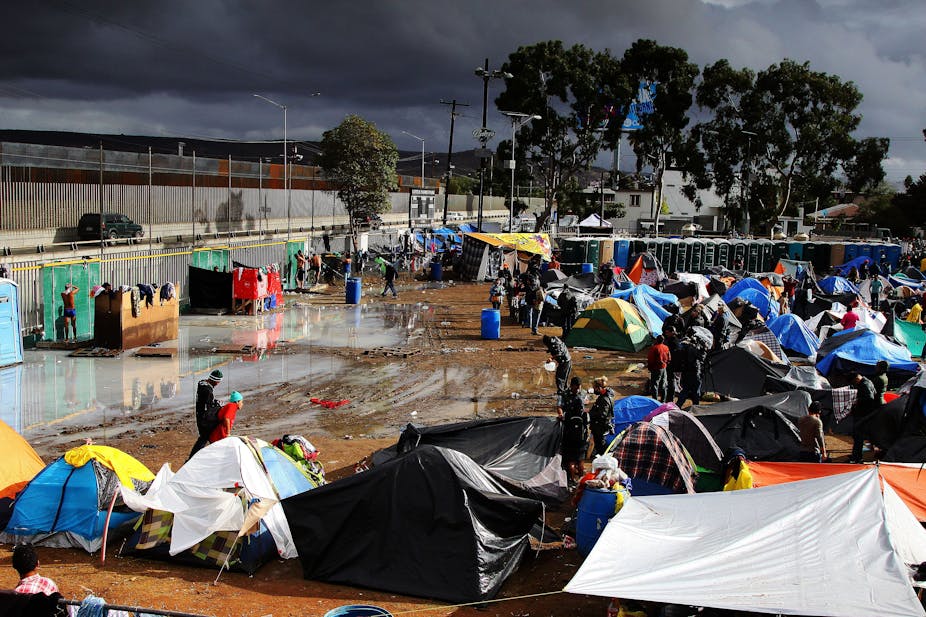The Global Compact for Safe, Orderly and Regular Migration (GCM) sets out a common, comprehensive approach to international migration. It aims at cooperation between states and promotes measures to strengthen regular migration pathways, to tackle irregular migration, and to protect human rights of migrants among other objectives. It is expected to be endorsed by the UN member states in mid-December in an intergovernmental conference in Marrakesh.
But it is also subject to growing controversy – and the number of countries opposing the pact is increasing almost daily. The Dominican Republic is the latest country to join Australia, Austria, Bulgaria, Israel, Poland, the Czech Republic and Slovakia in refusing to sign the document that they negotiated for 18 months.
The GCM is creating heated political tension in other countries, too. In Belgium, the government was even in danger of collapse over it. Italy and Estonia will not attend the conference. Switzerland, which led the negotiations as a co-facilitator, won’t back the GCM in Marrakesh either, instead delaying the decision until a vote in parliament. The US quit negotiations early on, in December 2017, and was followed by Hungary seven months later.
So why have so many countries decided not to endorse the pact that they negotiated?
The GCM is a voluntary, non-binding document that introduces no additional obligations to states. It is a global agreement setting out a common framework, shared principles and best practices on international migration.
The GCM emerged, and has been negotiated, in parallel with the Global Compact on Refugees (GCR) as a concrete commitment of the New York Declaration for Refugees and Migrants adopted by the UN General Assembly in December 2016. In contrast to the GCM, the GCR has been widely supported so far by the international community, with the recent exception of the US.
The final draft of the GCM was approved in July 2018 by all UN member states – except the US and Hungary – with the aim of becoming the first global framework on migration. As one of the interviewees in our ongoing research project on global migration stated, the GCM is “an aspirational document” but “it doesn’t impose and it fully respects the sovereignty of states”.
Many analysts have recognised that the final text is far from perfect. Yet most agree about the significance of the negotiation for multilateralism and global cooperation.

Several of our interviewees – high-level officials and decision makers in the field of migration – recognised that this was both the best and the worst moment to negotiate the GCM. The attention on migration in the past four years has created the conditions to start an unprecedented global negotiation, but within the most hostile environment possible. The risk of countries leaving the pact overshadowed the process from the beginning.
Not wanting to look welcoming
We can see four interrelated reasons that explain this growing opposition.
First, states with a restrictive migration agenda, such as Hungary, consider the symbolic act of approving the GCM as a sign that they are promoting migration. The regulation of migration is not only seen as a matter of laws, policies, and “border walls”, but also as a matter of communication. Some officials believe that if a country is perceived to be open towards immigration, it is providing incentives for migration, whereas harsh rhetoric is seen as a deterrent.
Such a perspective partly obscures the complexity and multifaceted reasons why people migrate. It is also unrealistic to believe that many would-be migrants closely follow the GCM process. But countries with a restrictive migration agenda don’t want to take any risks. Instead, their aim is to reaffirm their restrictive position by rejecting the GCM.
Second, while state officials are well aware that the GCM is non-binding, those that have rejected it fear it will turn into common practice, or even common law. In turn, advocates of the GCM have underlined that this is an inaccurate view. Its potential, though, lies somewhere in between. Some of our interviewees pointed out that, while not legally binding, it should be a politically guiding framework, which sets out ground rules for the long term.
Rights and the right-wing
Third, some states that have rejected the GCM are especially worried about human rights references within the document. In their view, an emphasis on human rights contradicts what matters for them: securing borders.
The Hungarian government argued that applying a human rights perspective to border control measures is “an extremely dangerous approach”. This position is based on a hyper-securitised view of immigration, in which migrants are seen predominantly as a threat. A framework that includes human rights of migrants, such as the GCM, is seen as incompatible with effective border control.
Fourth, hostility to the GCM mirrors the growing influence of new far-right movements, especially in countries where radical right parties are in power or are prominent. Ideas and myths about the GCM that circulated on extreme right social media sites, are said to have influenced Austria’s decision to withdraw.
In Italy, there was little discussion of the GCM until recently. But the extreme right, most notably the Fratelli d’Italia, ultimately managed to put the issue on the country’s political agenda.
There is a common denominator here: the rise of “sovereignism” as a political ideology. This is defined by anti-migrant nativism, and the rejection of multilateralism and international institutions. The GCM touches upon both of these core issues.
The question is not whether the GCM will be adopted, as a large majority of the 193 UN states still endorse it. Rather it is over the impact it is likely to have, given that its upcoming adoption has already been overshadowed by political statements that contradict the solidarity and multilateral approach to international migration it aims to promote.

